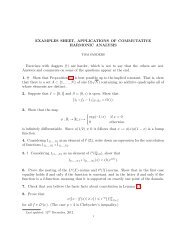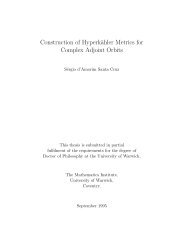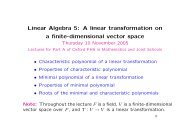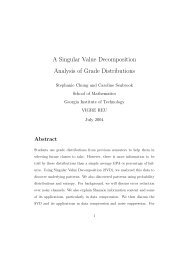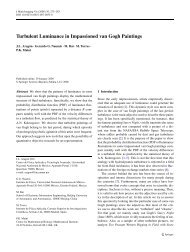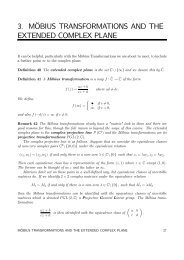Fourier Series and Partial Differential Equations Lecture Notes
Fourier Series and Partial Differential Equations Lecture Notes
Fourier Series and Partial Differential Equations Lecture Notes
You also want an ePaper? Increase the reach of your titles
YUMPU automatically turns print PDFs into web optimized ePapers that Google loves.
Chapter 3. The heat equation 31<br />
3.6 Non-zero steady state<br />
It may be that the temperatures of the ends x = 0 <strong>and</strong> x = L are prescribed <strong>and</strong> constant<br />
but not equal to zero.<br />
Example 3.3 Solve the IBVP<br />
subject to the initial condition<br />
<strong>and</strong> the boundary conditions<br />
∂T<br />
∂t = κ∂2 T<br />
∂x2, 0 < x < L, t > 0, (3.58)<br />
T(x,0) = 0, 0 ≤ x ≤ L, (3.59)<br />
T(0,t) = T0 <strong>and</strong> T(L,t) = T1 for t > 0. (3.60)<br />
We cannot use separation of variables <strong>and</strong> <strong>Fourier</strong> series right at the outset. However, we<br />
conjecture that, as t → ∞, T(x,t) → U(x), where<br />
i.e.<br />
κ d2 U<br />
dx 2 = 0, U(0) = T0 <strong>and</strong> U(L) = T1, (3.61)<br />
U(x) = T0<br />
<br />
1− x<br />
L<br />
<br />
+T1<br />
<br />
x<br />
<br />
. (3.62)<br />
L<br />
If we now put S(x,t) := T(x,t)−U(x), we find that S is a solution of the IBVP<br />
with<br />
∂S<br />
∂t = κ∂2 S<br />
∂x2, 0 < x < L, t > 0, (3.63)<br />
S(0,t) = 0 <strong>and</strong> S(L,t) = 0 for t > 0, (3.64)<br />
<strong>and</strong><br />
<br />
S(x,0) = −T0 1− x<br />
<br />
x<br />
<br />
−T1 . (3.65)<br />
L L<br />
In view of the form of the boundary conditions, this IBVP can be solved by our previous<br />
methods. The solution is<br />
<strong>and</strong> so<br />
T(x,t) = T0<br />
<br />
S(x,t) = 2<br />
π<br />
1− x<br />
L<br />
<br />
+T1<br />
∞<br />
n=1<br />
1<br />
n [−T0 +(−1) n T1]sin<br />
<br />
x<br />
<br />
+<br />
L<br />
2<br />
π<br />
∞<br />
n=1<br />
1<br />
n [−T0 +(−1) n T1]sin<br />
<br />
nπx<br />
<br />
e<br />
L<br />
−n2π2κt/L2 , (3.66)<br />
<br />
nπx<br />
<br />
e<br />
L<br />
−n2π2κt/L2 . (3.67)




